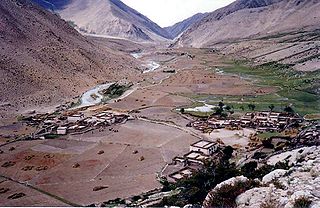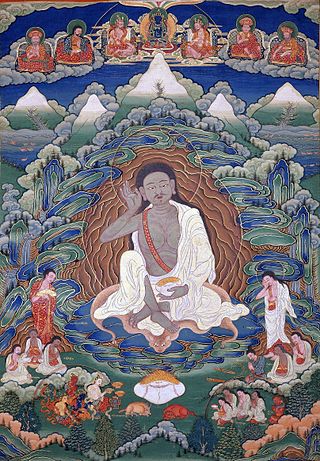Naktsang | |
|---|---|
| Coordinates: 27°23′N89°16′E / 27.383°N 89.267°E | |
| Country | |
| District | Haa District |
| Time zone | UTC+6 (BTT) |
Naktsang is a town in Haa District in southwestern Bhutan. [1] (Do not confuse with Naktsang Town in Shentsa County, Tibet.) [2]
Naktsang | |
|---|---|
| Coordinates: 27°23′N89°16′E / 27.383°N 89.267°E | |
| Country | |
| District | Haa District |
| Time zone | UTC+6 (BTT) |
Naktsang is a town in Haa District in southwestern Bhutan. [1] (Do not confuse with Naktsang Town in Shentsa County, Tibet.) [2]

The Palcho Monastery or Pelkor Chode Monastery or Shekar Gyantse is the main monastery in the Nyangchu river valley in Gyantse, Gyantse County, Shigatse Prefecture, Tibet Autonomous Region. The monastery precinct is a complex of structures which, apart from the Tsuklakhang Monastery, also includes its Kumbum, believed to be the largest such structure in Tibet, that is most notable for its 108 chapels in its several floors and the old Dzong or fort.

Milarepa's Cave or Namkading Cave is a cave where the Tibetan Buddhist philosopher, and Vajrayana Mahasiddha, Milarepa spent many years of his life in the eleventh century. It is located 11 kilometres (7 mi) north of the town of Nyalam at Gangka village. It is on the slope below the China–Nepal Friendship Highway and above the Matsang river in Nyalam County, Tibet.

Nyalam is a small town in and the county seat of Nyalam County in the Shigatse Prefecture of the Tibet Autonomous Region, near the Nepal border. It is 35 km from Zhangmu town in the same county, which is the point of entry to Nepal. Nyalam is situated at 3,750 metres (12,300 ft) above sea level.

Xainza County, also Shantsa, Shentsa, is a county within Nagqu of the Tibet Autonomous Region of China. In 1999 the county had a population of 16,190.

In Tibetan Buddhism and Bon, a ngagpa (male), or a ngagmo (female) is an ordained non-monastic practitioner of Dzogchen and Tantra. Traditionally, many Nyingma ngakpas wear uncut hair and white robes and these are sometimes called "the white-robed and uncut-hair group".

Drongpa County or Zhongba County (Tibetan: འབྲོང་པ་རྫོང་, Wylie: `brong pa rdzong, THL: drong pa dzong, ZYPY: Zhongba Zong; Chinese: 仲巴县; pinyin: Zhōngbā Xiàn; lit. 'Place of Wild Yaks') is a county of Shigatse Prefecture in China's Tibet Autonomous Region. Located in the western part of Central Tibet, it is the birthplace of the Tsangpo River (Brahmaputra). The county seat is at Labrang, which is also called the Drongpa Town.
Dorjidak Gompa or Tupten Dorjidak Dorjé Drak Éwam Chokgar is a Tibetan Buddhist monastery and one of the Nyingma school's "Six Mother Monasteries" in Tibet. It is located in the Lhoka (Shannan) Prefecture in the south of the Tibet Autonomous Region, older southeastern Ü-Tsang.
Xainza is a town and township-level administrative unit and seat of Shentsa County or Xainza County, Nagqu Prefecture, Tibet Autonomous Region, China.

Katok Monastery, also transliterated as Kathok or Kathog Monastery, was founded in 1159 and is one of the "Six Mother Monasteries" in Tibet of the Nyingma school of Tibetan Buddhism, built after Samye Monastery. It is located in Payul, Karze Prefecture, Sichuan, China, known as Kham.

The Samding Dorje Phagmo is the highest female incarnation in Tibet and the third highest-ranking person in the hierarchy after the Dalai Lama and the Panchen Lama. She was listed among the highest-ranking reincarnations at the time of the 5th Dalai Lama, recognized by the Tibetan government and acknowledged by the emperors of Qing China. In her first incarnation, as Chökyi Drönma, she was the student and consort of the famous polymath Thang Tong Gyalpo, who first identified her as an emanation of Vajravārāhī, and the consort of Bodong Panchen. The seat of the Samding Dorje Phagmo is at Samding Monastery, in Tibet.

Ngawa County, or Aba or Ngaba, is a county in the northwest of Sichuan Province, China. It is under the administration of the Ngawa Tibetan and Qiang Autonomous Prefecture. It is located in the remote northwestern part of the prefecture, on the border with Qinghai and Gansu. The county seat is Ngawa Town.

Saga is a town and township, and the seat of Saga County in Shigatse Prefecture, in southern Tibet. It lies at an altitude of 4,640 metres

Garzê or Ganzi, is a town and county seat in Garzê County, Garzê Tibetan Autonomous Prefecture in western Sichuan Province, China. Despite Garzê Prefecture being named after the town, the prefecture capital is Kangding, 365 km to the southeast. As of 2010, Garzê was home to 16,920 inhabitants. Garzê is an ethnic Tibetan township and is located in the historical Tibetan region of Kham. It contains the 15th century Kandze Monastery, home to over 500 Gelugpa monks.

Kandze Monastery is situated 2 km north of Garzê Town on a hilltop overlooking the town, in Tibet.

The Yarlung Valley is formed by Yarlung Chu, a tributary of the Tsangpo River in the Shannan Prefecture in the Tibet region of China. It refers especially to the district where Yarlung Chu joins with the Chongye River, and broadens out into a large plain about 2 km wide, before it flows into the Tsangpo River. It is situated in Nedong District of the Shannan Prefecture and includes the capital of the prefecture, Tsetang, one of Tibet's largest cities, 183 km southeast of Lhasa.

Taklung Monastery, Taklung stag-lung, Taklung Yarthang Monastery, Pel Taklug Tang or Taklung or Taglung Gompa is a Kagyu Buddhist monastery about 120 km north of Lhasa.

Riwoche Monastery, or Riwoche Tsukla Khang Tragyelma is a Taklung Kagyu monastery of the Kagyu school of Tibetan Buddhism. It was founded in 1276 by Sangye On, and is one of the oldest and largest monasteries in eastern Tibet. A highly respected Kham regional monastery, it's also famous for its philosophers and logicians, and for the red, black and white painted tree-trunk columns.
Liulin is situated adjacent to the major Tibetan Geluk Jonê Monastery, on the northern bank of the Lu-chu river in Jonê County, Gannan Tibetan Autonomous Prefecture, Gansu Province, China, at an altitude of about 2,610 m (8,563 ft).

Tsechen Monastery, Tsechen Dzong or Shambu Tsegu, was about 5 kilometres (3.1 mi) northwest of Gyantse above the traditional village of the same name. Tsechen was the largest of a number of hilltop monastery-forts ringing the valley, none of which would be easy to assault. The fortress, or dzong, was considered to be almost as strong as the Gyantse Dzong. It was "built on another precipitous hill about 600 feet [183 metres] high, about one mile [1.6 km] long, and rising abruptly out of the plain occupied by at least 1,000 of the enemy who cheered vociferously when they saw us retire."